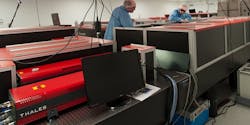One of the world's most powerful lasers--capable of bursts of light equivalent to twenty times all the power consumed on Earth, captured in fraction of a second--has been acquired by the University of Strathclyde (Glasgow, Scotland). The approximate $4.5 million dollar device is able to deliver peak powers with the highest repetition rate of any laser currently operational in a university laboratory, and can briefly recreate the physical conditions, such as pressures and temperatures, found in stars.
RELATED ARTICLE: Upgraded 200 TW laser at SLAC synchronizes with x-ray laser for research
The laser has numerous scientific applications including medical imaging, radiotherapy and generation of radioisotopes for imaging and cancer therapy. It is situated at the Strathclyde-based Scottish Centre for the Application of Plasma-based Accelerators (SCAPA), which delivers research into next-generation accelerators and radiation technology.
Gregor Welsh, a Research Fellow in Strathclyde's Department of Physics and Laser Manager of SCAPA, said, "This is a world-leading laser for any university--indeed, we believe it is the highest average powered lab-based laser of its type anywhere in the world. It acts as a light source which drives the applications and produces x-ray pulses that are short enough to take snapshots of molecular or solid state processes."
Dino Jaroszynski, director of SCAPA, added, "Our acquisition of this type of laser reflects Strathclyde's status as a world-leading centre of physics. Its important applications underline Strathclyde's international reputation for research with impact. It also forms part of a valuable training facility for PhD students."
The laser can produce beams with a peak power of 350 TW--equivalent to twenty times the world’s power consumption, or the sun's power reaching the earth over an area of 500 km x 500 km, for 25 fs, and produce up to 14 J of energy per pulse at 5 Hz.
The laser has been funded by Strathclyde and by the Scottish Universities Physics Alliance (SUPA), a partnership involving Strathclyde committed to sharing resource, strategic planning and expertise in physics research. It was designed and built by Thales. The Research Excellence Framework 2014, the comprehensive rating of UK universities' research, ranked the University of Strathclyde's Physics research first in the UK, with 96% of output assessed as world-leading or internationally excellent.
SOURCE: University of Strathclyde; https://www.strath.ac.uk/whystrathclyde/news/weacquireoneoftheworldsmostpowerfullasers/

Gail Overton | Senior Editor (2004-2020)
Gail has more than 30 years of engineering, marketing, product management, and editorial experience in the photonics and optical communications industry. Before joining the staff at Laser Focus World in 2004, she held many product management and product marketing roles in the fiber-optics industry, most notably at Hughes (El Segundo, CA), GTE Labs (Waltham, MA), Corning (Corning, NY), Photon Kinetics (Beaverton, OR), and Newport Corporation (Irvine, CA). During her marketing career, Gail published articles in WDM Solutions and Sensors magazine and traveled internationally to conduct product and sales training. Gail received her BS degree in physics, with an emphasis in optics, from San Diego State University in San Diego, CA in May 1986.
